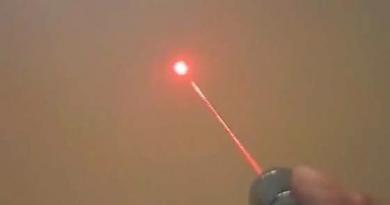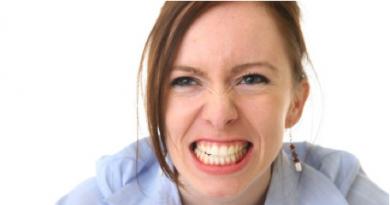Teeth grinding, or bruxism, is a rather unpleasant syndrome for the patient and a troublesome problem for his attending physician. In most cases, this phenomenon occurs in people with a labile nervous system. About 1-3% of the world's population, regardless of age, are prone to this condition.
Nocturnal bruxism is most common, but daytime teeth grinding is also present. To date, the main groups of pathological conditions and diseases that lead to bruxism have been fully studied.
Bruxism is based on involuntary spasms of masticatory muscles, closure of the jaws and convulsive uncontrolled movement of them in the lateral and anterior-posterior directions. At the same time, there is adhesion of the teeth to each other by chewing surfaces, which ultimately leads to friction with grinding. In addition, a number of other deviations can be observed, a drop in blood pressure, a slow pulse, and apnea. Grinding can last from a few seconds to a couple of minutes.
Bruxism in adults: causes
Inflammation of the temporomandibular joints
As a result, it leads to dysfunction of the joints. This violation can be heard in the form of a click when the mouth is opened wide (usually when yawning). Chronic inflammation in the temporomandibular joint leads to an increase in nerve impulses and can stimulate a sudden spasm of the masticatory muscles. Contracting, the muscles begin to move the lower jaw, which provokes a characteristic rattle. A vicious circle develops here: muscle spasm provokes inflammation, while inflammation is supported by spasm, all this disrupts the normal ratio of joint surfaces.
Nervous disorders
The presence of chronic neurotic conditions and exhaustion of the nervous system due to prolonged physical or mental stress. Most often, daytime bruxism develops on a nervous basis. One of the functions of sleep is to get rid of unnecessary information and process it, so in a dream a person continues to experience daytime problems, cannot relax and begins to grind his teeth.
Nocturnal bruxism coincides in time with REM sleep, including episodes of restless sleep: active movements of the eyeballs, involuntary muscle twitches.
Often there is a combination of creaking with enuresis, sleepwalking, talking in a dream, snoring.
Such patients often suffer from a bad habit during the daytime, namely, during the experience, they bite their nails or objects (toothpicks, matches, pens, pencils).

Action of neurotoxins
The most common are household poisons that poison the central nervous system - nitro dyes, nicotine, alcohol.
dental problems
Anomalies and pathologies of the jaws and dentition:
a common example is complicated eruption of wisdom teeth;
inflammation in the area of implants can provoke spasm of masticatory muscles and bruxism;
the presence of improperly fitted fixed prostheses;
malocclusion.
bruxism symptoms
The daytime variant of the syndrome can be noticed by the patient himself, while the night squeak is usually reported by relatives and relatives, who are often frightened by such behavior on the part of the patient.
Typical manifestations of bruxism are:
grinding or grinding of teeth;
pain in facial muscles, especially temporomandibular, in the morning;
loosening of teeth, their traumatic chips and fractures;
increased sensitivity of tooth enamel to hot, cold, sweet, due to its gradual erasure;
chronic inflammation of the temporomandibular joints, which lead to limited jaw movement;
violation of the depth of night sleep provokes constant lack of sleep, headaches, daytime sleepiness and chronic fatigue syndrome.
Additional discomfort from bruxism
bruxism may be a contraindication for the installation of inlays, crowns, implantation of implants, since even the softest crown material will crumble the enamel of the antagonist tooth;
in addition to objective changes in the state of the osteoarticular apparatus, teeth and muscles, a significant problem is discomfort for the patient's relatives and the gradual neuroticization of the patient himself, if he knows about the presence of the syndrome.
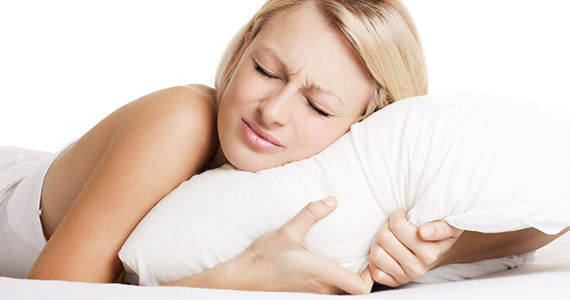
Theory about the relationship of bruxism with helminthic invasions
There is an opinion among the people that the grinding of teeth in a dream, especially if it develops in children, indicates the presence of helminthic invasions. This is what can justify the method of treating bruxism with garlic. In fact, there is no direct interdependence between these two pathological conditions. Grinding teeth can be a child or an adult who does not have worms and never has. From the point of view of science, the connection between two states can be explained by two points.
Firstly, with any helminthic invasion, neurotization of the patient may occur.
Secondly, in many intestinal helminthiases, there is a decrease in the production of vitamin B12, which worsens neuromuscular transmission and can become a prerequisite for disruption of the masticatory muscles of the temporomandibular joint.
Thirdly, B12-deficiency anemia disrupts oxygen transport to the brain, which can affect the change in the depth of sleep and provoke involuntary muscle spasms of the type of partial convulsions, including trismus of chewing muscles.
Why does a child grind his teeth in a dream?
According to various sources, bruxism occurs in 15-50% of the child population.
The causes of this condition most often lie in the plane of neurological problems, asthenia or frequent fatigue, as well as in anomalies in the structure of the jaws, facial skeleton and bite pathologies.
Do not deny the influence of heredity. About 80% of children who suffer from nocturnal bruxism have a parent who suffered from nocturnal bruxism at the same age.
In some cases, the squeak appears after a long infectious pathology or after weaning the baby from the nipple.
Grinding of teeth and adenoids
Up to 80% of babies who have adenoids also suffer from bruxism. This is due to a violation of nasal breathing and a decrease in the depth of sleep, as a result of which either the left or the right hemisphere of the brain is stimulated at different times of the day.
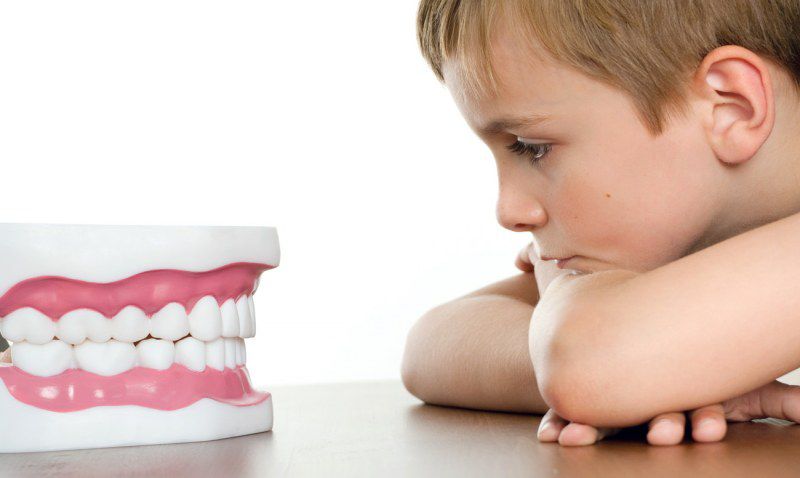
Grinding teeth and epilepsy
Quite interesting are the studies that have been conducted to determine whether there is a link between epilepsy and bruxism. According to EEG data, in children who suffer from grinding of teeth, the falling asleep phase is shortened, while episodes of bruxism occur more often in the first slow and second phases of sleep. There is a direct relationship between sleepwalking and dental squeaking, as well as loss of consciousness and talking in a dream in the past. There is no association between seizures in epilepsy and bruxism. Most often, more mobile children who began to sit, stand, walk early, as well as those who spoke earlier than their peers, suffer from dental squeaking.
If the baby suffers from short (less than 10 seconds) and infrequent bouts of grinding for two months, you can usually get by with the organization of the daily routine, go to bed early and add daytime sleep, it is also worth limiting the time of classes and being at the computer. Quite often, these episodes go away on their own without additional therapy.
In the presence of frequent and prolonged seizures, which are combined with other manifestations of violations of the depth of sleep, the child must be shown to a neurologist (prescribe herbal sedatives, examination of the fundus, EEG). It is also worth consulting with a dentist to determine the presence of orthodontic problems. Most often, children's bruxism is corrected with silicone tires on air cushions, usually from the age of 3-5 years.
Treatment:
limit the factors that provoke stress;
it is enough to walk in the fresh air, in order to avoid oxygen starvation of the brain;
do not drink drinks that stimulate the central nervous system (soda, alcohol, energy drinks, coffee, strong tea) at night;
use silicone caps;
dry heat on the projection of the masticatory muscles before going to bed;
herbal sedatives.
Silicone caps prevent tooth wear and can be ordered from a dentist. The cap is placed in the mouth before going to bed. It forms the correct bite and does not allow the surfaces of the teeth to come into contact with each other. You can also purchase a standard mouth guard and adjust it to fit your own bite. Such orthodontic devices consist of two parts, each of them has a handle-petal. The device is placed in boiling water (up to 10 seconds) to make the silicone plastic, after which it is shaken off and inserted into the mouth. After that, you need to squeeze your jaws 3-4 times with force, leaving an impression of your own teeth on the cap. After that, the handles are cut off. The tray obtained in this way is securely fixed in the mouth and prevents the teeth from being erased during sleep.
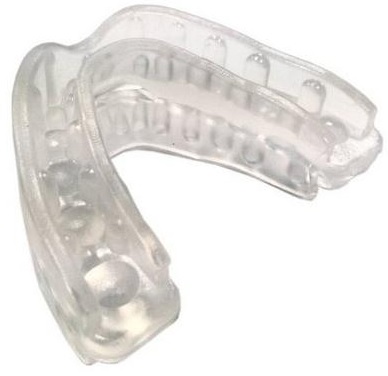
In the presence of the daytime form of bruxism, dentists also use various splint modifications, which prevent the abrasion of tooth enamel and are not noticeable when placed in the oral cavity.
In the most severe cases, your doctor may prescribe antidepressants and muscle relaxants.
Thus, today bruxism can be attributed to various areas of medicine. Therefore, when teeth grinding is detected in a child or an adult, at least 2 specialists should be examined: a dentist and a neuropathologist.


